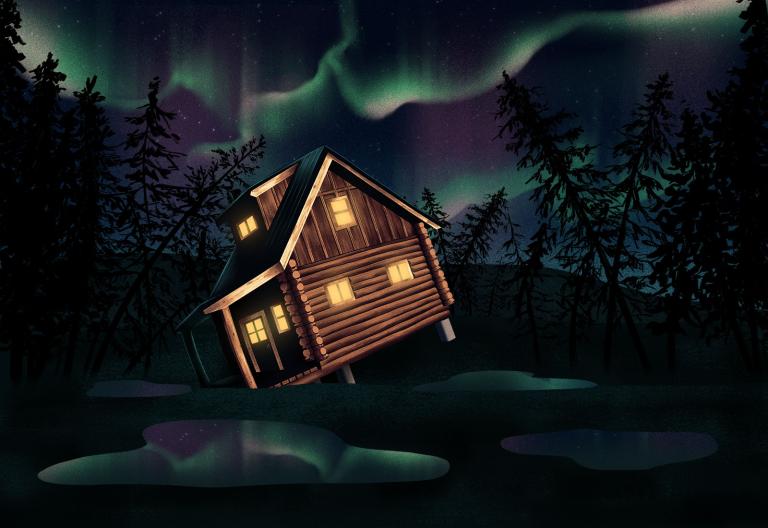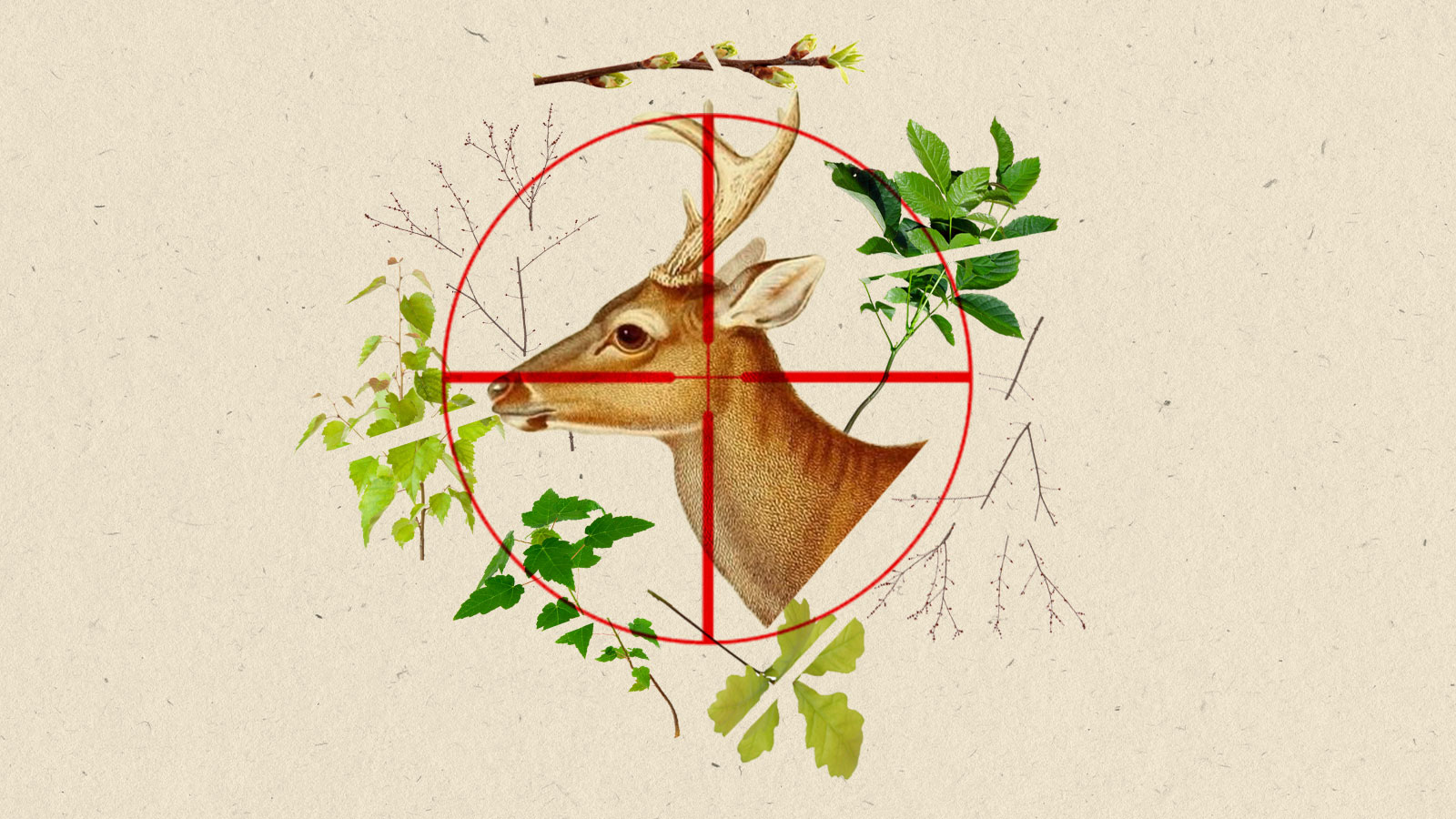As spring arrived in southwestern Alaska, a handful of people from the state Department of Fish and Game rose early and climbed into small airplanes. Pilots flew through alpine valleys, where ribs of electric green growth emerged from a blanket of snow. Their shadows crisscrossed the lowland tundra, where thousands of caribou had gathered to calve. Seen through the windscreen, the vast plains can look endless; Wood-Tikchik State Park’s 1.6 million acres comprise almost a fifth of all state park land in the United States.
As the crew flew, it watched for the humped shape of brown bears lumbering across the hummocks. When someone spotted one, skinny from its hibernation, the crew called in the location to waiting helicopters carrying shooters armed with 12-gauge shotguns.
Over the course of 17 days, the team killed 94 brown bears — including several year-old cubs, who stuck close to their mothers, and 11 newer cubs that were still nursing — five black bears and five wolves. That was nearly four times the number of animals the agency planned to cull. Fish and Game says this reduced the area’s bear population by 74 percent, though no baseline studies to determine their numbers were conducted in the area.
The goal was to help the dwindling number of Mulchatna caribou by reducing the number of predators around their calving grounds. The herd’s population has plummeted, from 200,000 in 1997 to around 12,000 today. But the killings set off a political and scientific storm, with many biologists and advocates saying the operation called into question the core of the agency’s approach to managing wildlife, and may have even violated the state constitution.
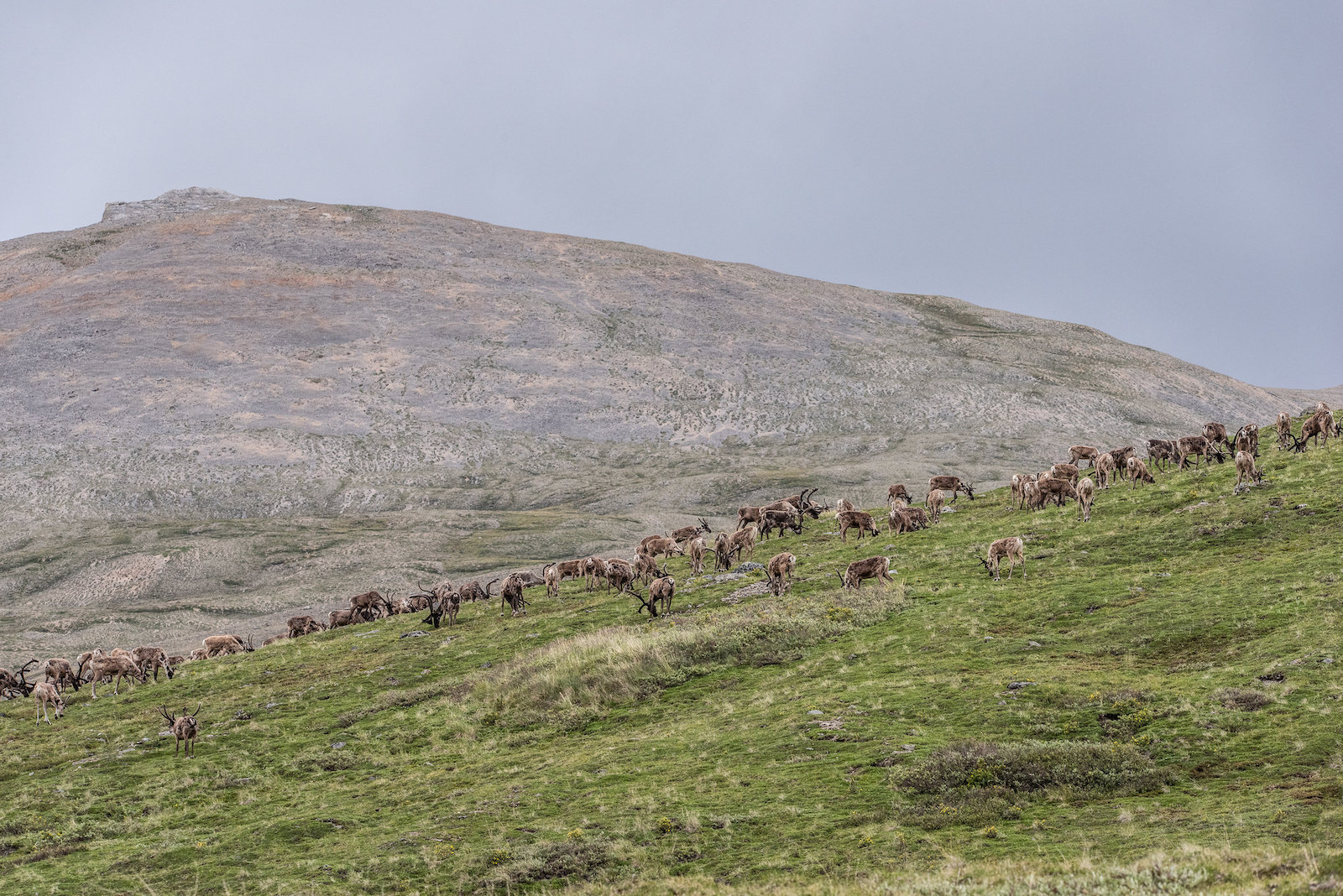
The Board of Game, which has regulatory authority over wildlife, insisted that intensive control of predators in Wood-Tikchik was the best way to support the struggling herd. But the caribou, which provide essential food and cultural resources for many Alaska Native communities, are facing multiple threats: A slew of climate-related impacts have hampered their grazing, wildfires have burned the forage they rely on, warmer winters may have increased disease, and thawing permafrost has disrupted their migrations.
With conditions rapidly changing as the planet warms, wildlife managers nationwide are facing similar biodiversity crises. Rather than do the difficult work of mitigating rising temperatures, state agencies across the country are finding it easier to blame these declines on predation.
“We don’t want to talk about how the tundra is changing, because that’s something we can’t fix,” says Christi Heun, a former research biologist at Alaska Fish and Game.

In Wyoming, where a deadly winter decimated pronghorn and mule deer, the state spent a record $4.2 million killing coyotes and other predators and is considering expanding bear and mountain lion hunts. Wildlife officials in Washington are contemplating killing sea lions and seals to save faltering salmon populations from extinction. In Minnesota, hunters are inaccurately blaming wolves for low deer numbers and calling for authorities to reduce their population. Culls like these are appealing because they are tangible actions — even when evidence suggests the true threat is much more complex. “You’re putting a Band-Aid on the wrong elbow,” says Heun, who now works for the nonprofit Defenders of Wildlife.
As the climate crisis intensifies, she and others say, wildlife management strategies need to shift too. “All we can do is just kind of cross our fingers and mitigate the best we can,” she adds. For people whose job is to control natural systems, “that’s a hard pill to swallow.”

In January 2022, a flurry of snow fell as the Alaska Board of Game gathered in Wasilla, far from where the Mulchatna caribou pawed through drifts, steam rising from their shaggy backs. Its seven members are appointed by the governor. Though they make important decisions like when hunting seasons open, how long they last, and how many animals hunters can take, they are not required to have a background in biology or natural resources. They also do not have to possess any expertise in the matters they decide. Board members, who did not respond to requests for comment, tend to reflect the politics of the administration in office; currently, under Republican Governor Mike Dunleavy, they are sport hunters, trappers, and guides.
That day, the agenda included a proposal to expand a wolf control program from Wood-Tikchik onto the Togiak National Wildlife Refuge — though that would require federal approval from the U.S. Fish and Wildlife Service; the government ultimately rejected the proposal.
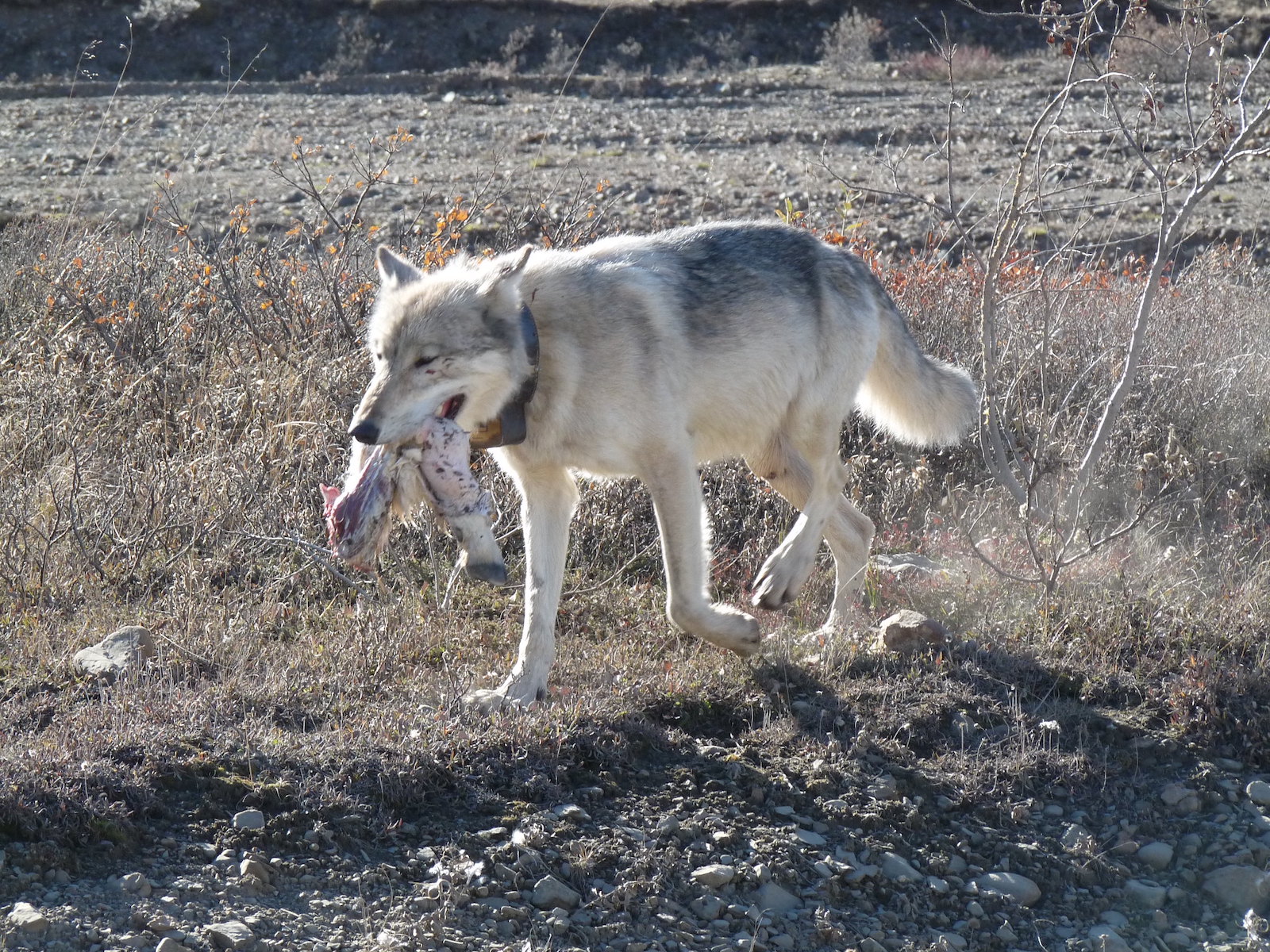
A wolf carries a piece of prey while walking through a national park in Alaska. National Park Service
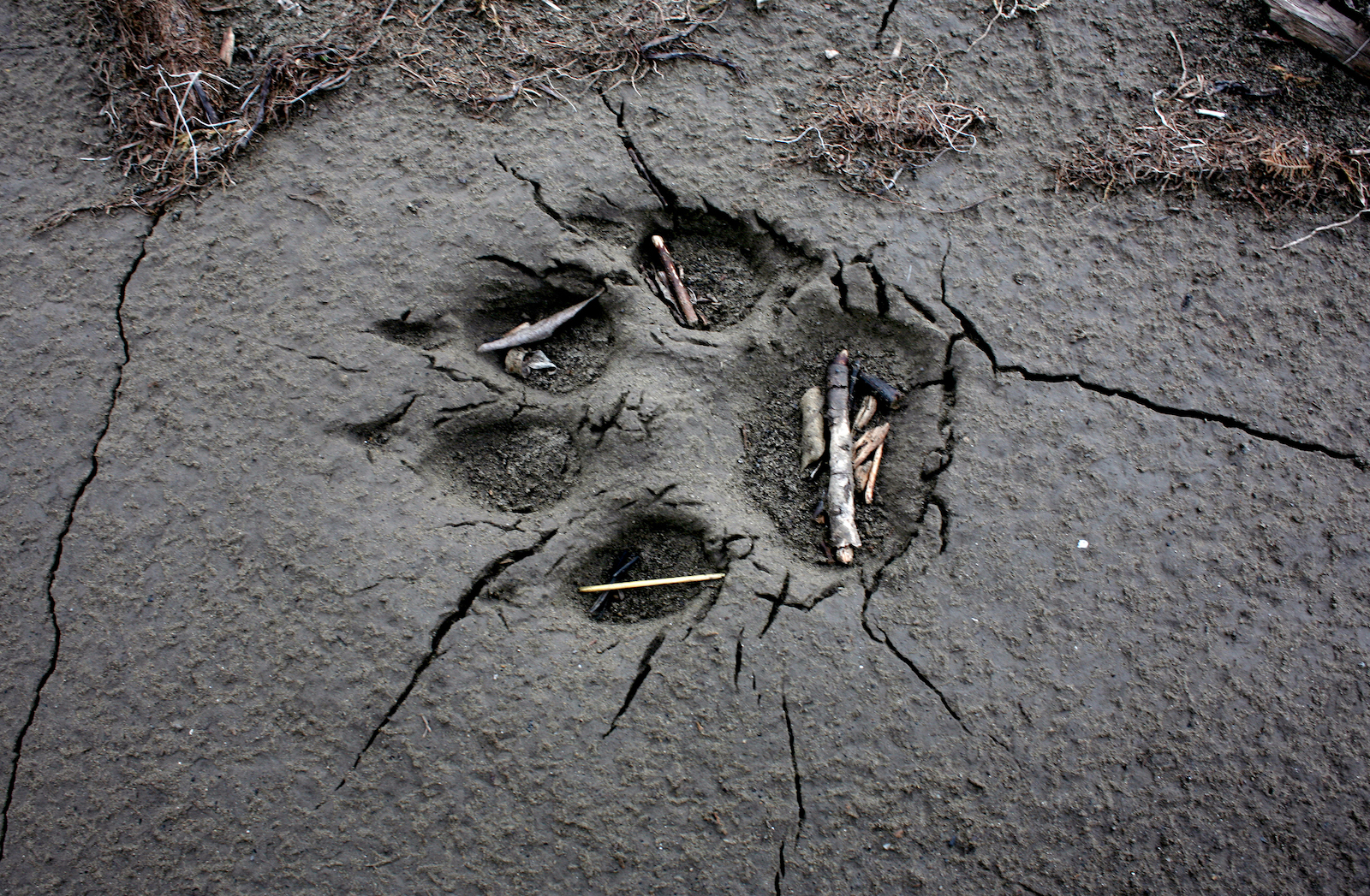
Hoof prints and paw prints, left, dot the sand in Togiak Nation Wildlife Refuge. Steve Hillebrand / U.S. Fish and Wildlife Service. A wolf print, right, is seen in the mud near calving grounds for one of Alaska’s major caribou herds. Andrew Lichtenstein / Corbis via Getty Images

The conversation began with two Fish and Game biologists summarizing their research for the board on the herd. Nick Demma explained that, like most ungulates, on average half of Mulchatna’s calves survive. In a study he conducted, many died within two weeks of birth; he mentioned as an aside that their primary predators are brown bears. “But I want to stress that this basic cause of death and mortality rate information is of little use,” he quickly added. Predator and prey dynamics are complex: The calves may have died anyway from injury or disease, and their removal may reduce competition for food and resources, improving the herd’s overall health.
When Demma tried to analyze the existing wolf control program, he found he didn’t have the data he needed to see if removing the canines helped calves survive. In fact, from 2010 to 2021, when Fish and Game was actively shooting wolves, fewer caribou survived. So the researchers turned their attention to other challenges the herd might be facing.
His colleague, Renae Sattler, explained that preliminary data from a three-year study suggested there could be a problem with forage quality or quantity, especially in the summer. This could lower pregnancy rates or increase disease and calf mortality. In the 1990s, the herd had swelled as part of a natural boom-and-bust cycle, leading to overgrazing. The slow-growing lichen the animals rely on takes 20 to 50 years to recover. Compounding that, climate change is altering the tundra ecosystem the animals rely upon. She also found that today, 37 percent of the sampled animals had, or were recently exposed to, brucellosis, which can cause abortions, stillbirths, and injuries. Biologists consider such high levels of disease an outbreak and cause for concern.
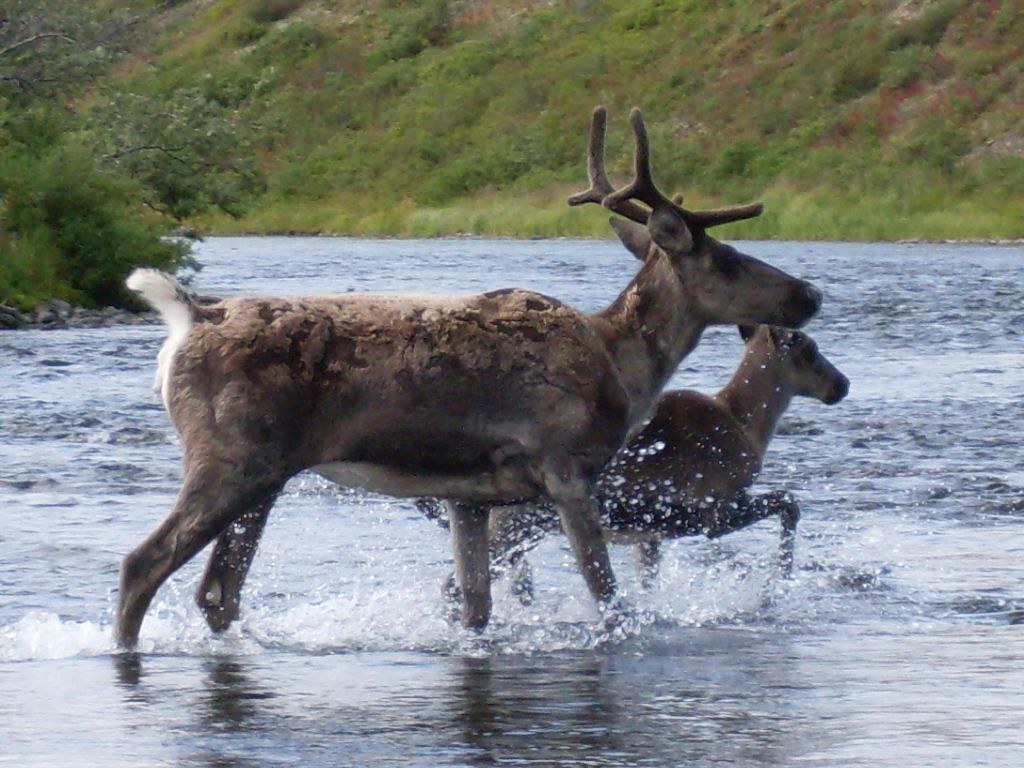
Sattler also noted that half of the animals that died in the study’s first year were killed by hunters taking them out of season — meaning the predators killing the most adult caribou were people. For all these reasons, the biologists suggested that the Board of Game reconsider the wolf control program.
Commissioner Doug Vincent-Lang, who oversees the agency, immediately questioned their conclusions, and their recommendation. Killing predators, he said during the meeting, “seems like one of the only things that’s within our direct control.” In other words, it was better than doing nothing.
Demma seemed taken aback, and chose his words carefully. “I guess what we are kind of trying to present there is just the information,” he told the board. “It’s — you know — wolves aren’t an important factor right now.” The meeting broke for lunch. When it resumed, the board unanimously voted to continue the wolf program through 2028, and, even more surprisingly, to add brown and black bears over a larger area. The public and Fish and Game biologists didn’t have the typical opportunity to comment on this expansion of predator control.
When he heard what happened, “I just was stunned. I was shocked,” says Joel Bennett, a lawyer and a former member of the Board of Game for 13 years. A hunter himself, Bennett served on the board under four governors and recalls his colleagues having a greater diversity of backgrounds and perspectives. Their votes were always split, even on less contentious issues. The unanimous vote “in itself indicates it’s a stacked deck,” he says. That’s a problem, because “the system only works fairly if there is true representation.”
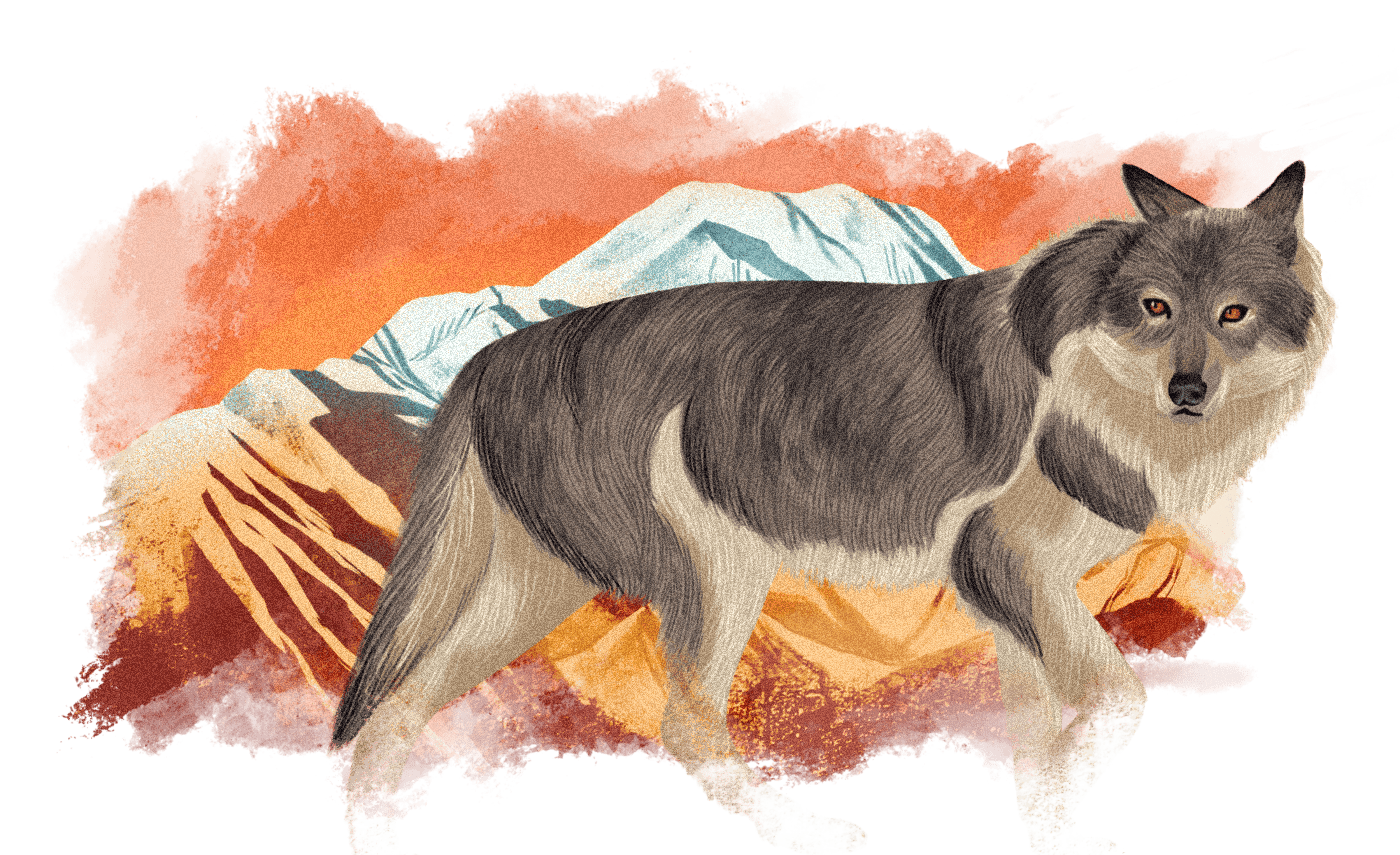
In August, Bennett and the Alaska Wildlife Alliance filed a lawsuit claiming the agency approved the operation without the necessary “reasoned decision-making,” and without regard for the state’s due process requirements. Bennett also was troubled that the state has tried to keep information about the cull private, including where the bears were killed. He suspects that, to have slain so many animals in just 17 days, the flights might have veered beyond the targeted area. He also wonders if any animals were left wounded. “Why are they hiding so many of the details?” he asked. A public records request reveals that although the board expected the removal of fewer than 20 bears, almost five times that many were culled without any additional consideration.
Alaska’s wildlife is officially a public resource. Provisions in the state constitution mandate game managers provide for “sustained yields,” including for big game animals like bears. That sometimes clashes with the Dunleavy administration’s focus on predator control. In 2020, for example, the board authorized a no-limit wolf trapping season on the Alexander Archipelago, a patchwork of remote islands in southeast Alaska. It resulted in the deaths of all but five of the genetically distinct canines. The Alaska Wildlife Alliance sued, a case Bennett is now arguing before the state Supreme Court. “That was a gross violation of ‘sustained yield’ in anyone’s definition,” he says, adding that even today, there is no limit on trapping wolves there.
Once, shooting bison from moving trains and leaving them to rot was widely accepted. Attitudes have evolved, as have understandings about predators’ importance — recent research suggests their stabilizing presence may play a crucial role in mitigating some of the effects of climate change. Other studies show predators may help prey adapt more quickly to shifting conditions. But Bennett worries that, just as Alaska’s wildlife faces new pressures in a warming world, management priorities are reverting to earlier stances on how to treat animals. “I’ve certainly done my time in the so-called ‘wolf wars,’” Bennett says, “but we’re entering a new era here with other predators.”

Even as legal challenges to the board’s decisions move forward, scientific debate over the effectiveness of predator control has flourished. Part of the problem is that game management decisions are rarely studied in the way scientists would design an experiment. “You’ve got a wild system, with free-ranging animals, and weather, and other factors that are constantly changing,” says Tom Paragi, a wildlife biologist for the state Department of Fish and Game. “It’s just not amenable to the classic research design.” Even getting baseline data can take years, and remote areas like Wood-Tikchik, which is accessible only by air or boat, are challenging and expensive places to work.
Paragi has for more than a decade monitored the state’s intensive wildlife management programs and believes predator control can be effective. Looking at data collected since 2003, he notes that when Alaska culled wolves in four areas in a bid to bolster moose, caribou, and deer populations, their numbers increased. They also remained low in those areas where wolves were left alone. (His examination of this data has not yet been published or subject to peer review.) Elsewhere in the state, removing 96 percent of black bears in 2003 and 2004, reducing hunting, and killing wolves boosted the number of moose. Heavy snowfall during the next two winters killed many of the calves, and most of the bears returned within six years, but Paragi still considers the efforts a success. By 2009, the moose population had almost doubled.
He’s also not convinced that Demma and Sattler were right when they told board members that predation doesn’t appear to be the most pressing issue for the Mulchatna caribou. He says record salmon runs have likely brought more bears near the park and the calving grounds, and warmer temperatures have fostered the growth of vegetation that provides places to hide as they stalk caribou. As to the suggestion that the herd is suffering from inadequate food supplies, he notes that their birth rate has been high since 2009. That’s often a strong indicator of good nutrition.
But Sattler says, “It isn’t that cut-and-dried.” A female caribou’s body condition, she explains, exists on a spectrum and affects her survival, the size and strength of any calves, and how long she can nurse or how quickly she gets pregnant again. “The impact of nutrition is wide-reaching and complex, and it isn’t captured in pregnancy rates alone.” Understanding how nutrition, brucellosis, and other factors are impacting the herd is complicated, she says.
There are a lot of interacting factors at play on the tundra — and among those trying to determine how best to help the herd. “Part of the frustration on all sides of this is that people have different value systems related to managing wild systems,” Paragi says. To him, last spring’s bear kill wasn’t truly a question of science. “We can present the data, but what you do with the data is ultimately a political decision,” he says.
Sterling Miller, a retired Fish and Game research biologist and former president of the International Association for Bear Research and Management, acknowledges that crafting regulations is left to the politically appointed Board of Game. But Miller says the agency tends to dismiss criticism of its predator control, when there are valid scientific questions about its effectiveness. In 2022, Miller and his colleagues published an analysis, using Fish and Game harvest data, showing that 40 years of killing predators in an area of south-central Alaska didn’t result in more harvests of moose. “Fish and Game has never pointed out any factual or analytical errors in the analyses that I’ve been involved with,” he says. “Instead, they try to undercut our work by saying it’s based on values.”
Miller also was involved in what remains one of the agency’s best examples of predator relocations. In 1979, he and another biologist moved 47 brown bears out of a region in south-central Alaska, which resulted in a “significant” increase in the survival of moose calves the next fall. But Miller says Fish and Game often misquotes that work. In reality, due to a lack of funding, Miller didn’t study the young animals long enough to see if they actually reached adulthood. Similarly, Fish and Game conducted an aerial survey this fall of the Mulchatna herd, finding more calves survived after the bear cullings. But Miller and other biologists say that’s not the best metric to measure the operation’s success: These calves may still perish during their first winter.
The Alaskan government is the only one in the world whose goal is to reduce the number of brown bears, Miller says, despite the absence of baseline studies on how many bears are in this part of the state. It irks him that the state continues to use his research as justification for allowing predator measures like bear baiting. In most parts of Alaska, Miller says, “the liberalization of bear hunting regulations has just been so extreme.”
While last year’s bear killings were particularly egregious, similar cullings have gone largely unnoticed. State data shows over 1,000 wolves and 3,500 brown and black bears have been killed since 2008 alone. In 2016, for example, the federal government shared radio tag information with the state, which used it to kill wolves when they left the safety of the Yukon-Charley Rivers National Preserve — destroying so many packs that it ended a 20-year study on predator-prey relationships. “There weren’t enough survivors to maintain a self-sustaining population,” recounted an investigation by the nonprofit Public Employees for Environmental Responsibility. The nearby caribou herd still failed to recover.
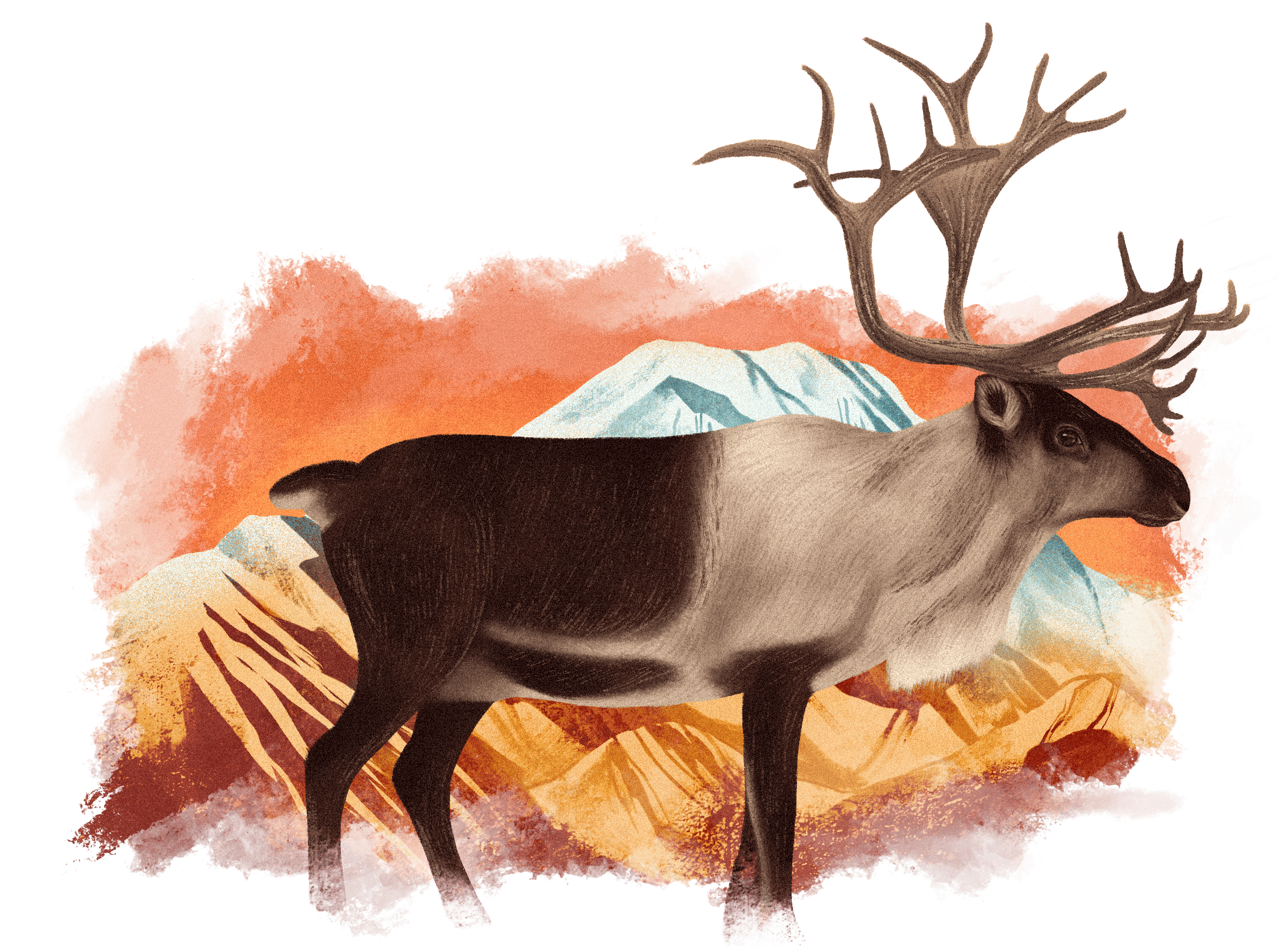
Multiple employees for Fish and Game, who didn’t want to be named amid fear of repercussions, told Grist that the agency was ignoring basic scientific principles, and that political appointees to the Board were not equipped to judge the effectiveness of these programs.
Even these criticisms of the agency’s science have been subject to politics: This summer, a committee of the American Society of Mammalogists drafted a resolution speaking out about Alaska’s predator control — only for it to be leaked to Fish and Game, which put up enough fuss that it was dropped. Link Olson, the curator of mammals at the University of Alaska Museum of the North, was one of many who supported the group taking a position on the issue. Olson says that even as someone who “actively collect[s] mammal specimens for science,” he is deeply concerned with Alaska’s approach to managing predators.
A month later, 34 retired wildlife managers and biologists wrote an open letter criticizing the bear cull and calling the agency’s management goals for the Mulchatna herd “unrealistic.” Meanwhile, neither Demma nor Sattler, the biologists who cautioned the board, are still studying the herd; Demma now works in a different area of the agency, and Sattler has left the state and taken a new job, for what she says are a variety of reasons.

Every fall, millions of people follow a live-streamed view of the biggest bears in Katmai National Park, which sits southeast of Wood-Tikchik. The animals jockey for fish before their hibernation, in an annual bulking up that the National Park Service has turned into a playful competition, giving the bears nicknames like “Chunk,” and, for a particularly large behemoth, 747.
Though marked on maps, animals like 747 don’t know where the comparative safety of the national park ends and where state management begins. This can mean the difference between life and death, as Alaskan and federal agencies have taken very different approaches to predator control: The National Park Service generally prohibits it. This has sparked a years-long federalism battle. Back in 2015, for example, the Board of Game passed a rule allowing brown bear baiting in the Kenai National Wildlife Refuge, leading the Fish and Wildlife Service to ban it in 2016. The state sued, and in 2020 the Trump administration proposed forcing national wildlife refuges to adopt Alaska’s hunting regulations. Similarly, the National Park Service challenged whether it had to allow practices like using spotlights to blind and shoot hibernating bears in their dens in national park preserves. In 2022, the 9th U.S. Circuit Court of Appeals ruled that federal agencies have ultimate authority over state laws in refuges; last year, the Supreme Court declined to hear the case.
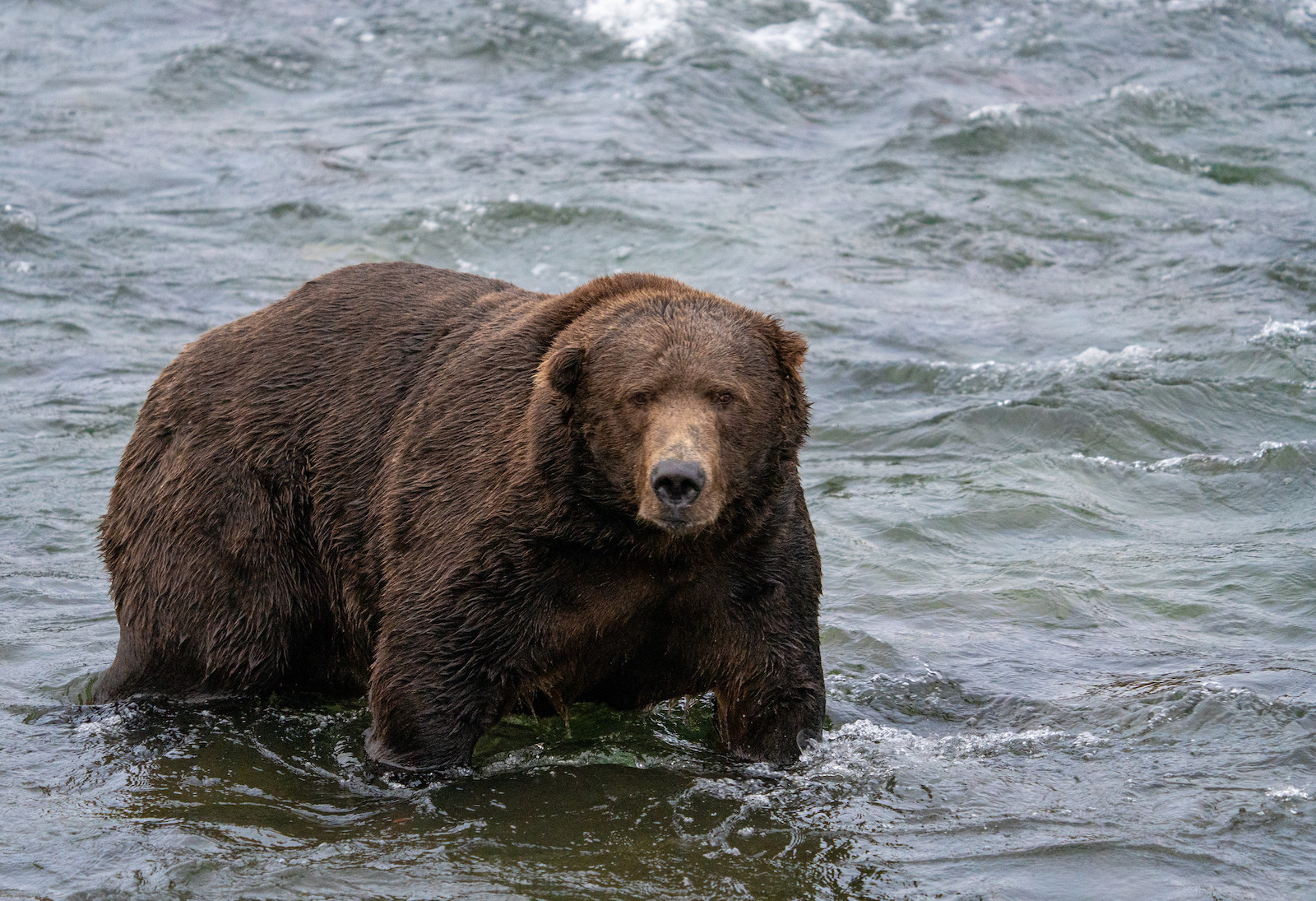
How these agencies interact with local communities is markedly different, too. Both Alaska Fish and Game and the U.S. Fish and Wildlife Service have regional advisory groups where residents can weigh in on game regulations, but Alissa Nadine Rogers, a resident of the Yukon- Kuskokwim Delta who sits on each, says that, unlike the federal government, it feels like “the state of Alaska does not recognize subsistence users as a priority.” On paper, the state prioritizes subsistence use, but under its constitution, Alaska can’t distinguish between residents, whereas the federal government can put the needs of local and traditional users first. This has frequently led to separate and overlapping state and federal regulations on public lands in Alaska.
Many people in the region rely on wildlife for a substantial part of their diet. Since the area isn’t connected by roads, groceries must be barged or flown in, making them expensive — a gallon of milk can cost almost $20. In addition to being an important food source, caribou are a traditional part of her Yupik culture, Rogers explains, used for tools and regalia. It’s a real burden for local communities to be told they can’t hunt caribou, which has driven poaching. As state and federal regulations have increased restrictions on hunting, she says residents have difficulty obtaining enough protein to sustain themselves through the winter. “If people don’t understand how it is to live out here, what true perspective do they have?” she asks. “Subsistence users are the ones who bear the burden when it comes to management. And a lot of the time, folks aren’t feeling that their voices are being heard or adequately represented.”
Yet Rogers says state and federal systems can provide an important balance to each other, and she approves of Fish and Game’s predator control efforts. As the former director of natural resources for the Orutsararmiut Native Council, she helped the council write a resolution, later passed by the statewide Alaska Federation of Natives, supporting last spring’s bear and wolf cull. She thinks officials should focus more on climate change but believes culling remains a useful tool. “It gives a vital chance for the [caribou] population and immediately supports growth and recovery,” Rogers says. She also asked Fish and Game to institute a five-year moratorium on all hunting of the herd. “If we go any lower, then we’re pretty much gonna be facing extinction.”
Who gets to make choices about the state’s fish and wildlife resources is a point of increasing tension this year, as a lawsuit unfolds between the state and federal government over who should manage salmon fisheries on the Kuskokwim River, to the west of the Togiak refuge. All five of its salmon returns have faltered for over a decade — making game like caribou even more critical for local communities. (In sharp contrast, to the east of the river, Bristol Bay has seen record recent returns, showing how variable climate impacts can be.) The Alaska Native Federation and the federal government say fishing should be limited to subsistence users, while the state has opened fishing to all state residents.
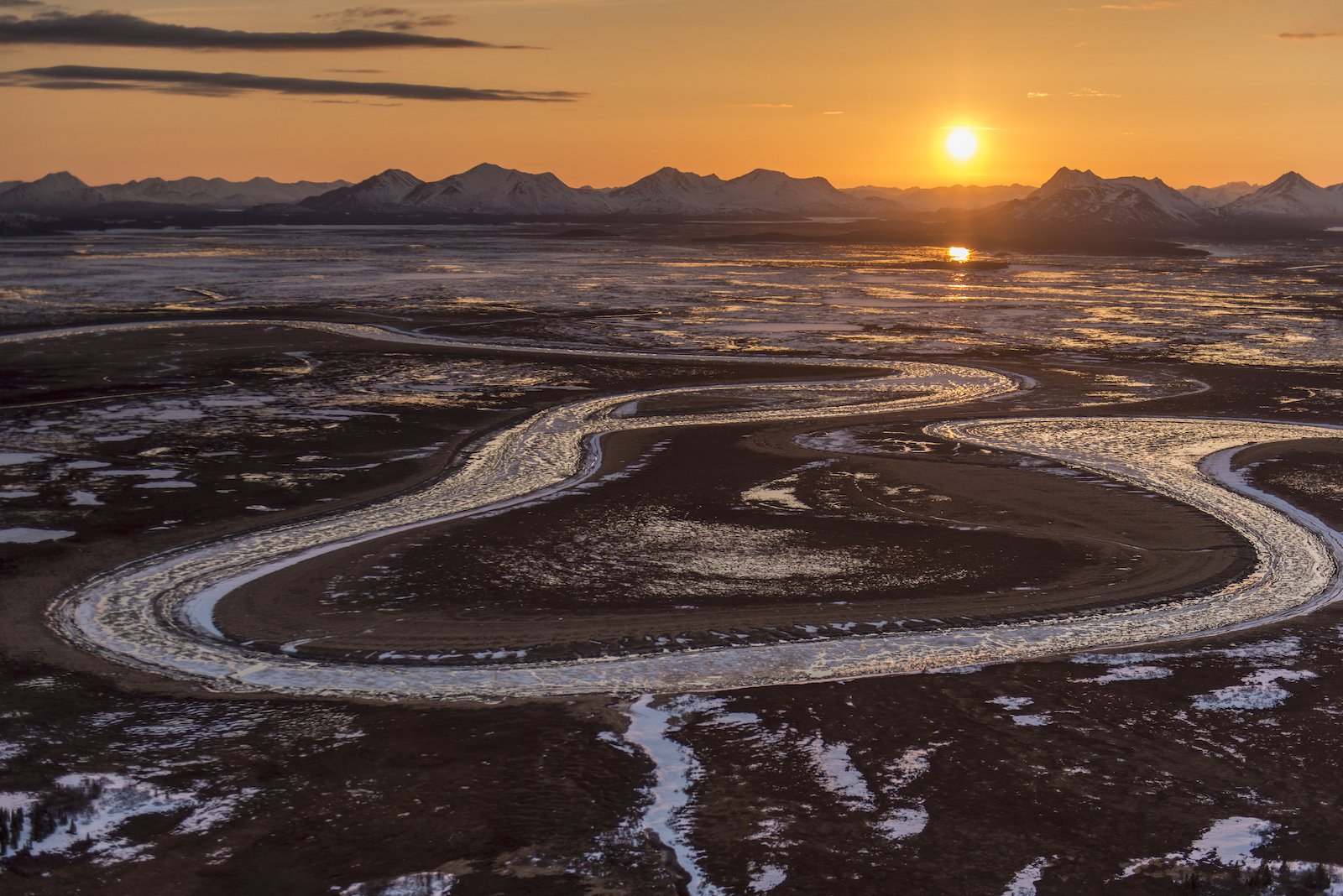
To ensure Alaska Native communities have a voice in such critical decisions, the Federation called for tribally designated seats on the Board of Game this fall. “We need to have a balanced Board of Game that represents all Alaskans,” says former Governor Tony Knowles. He, too, recommends passing a law to designate seats on the board for different types of wildlife stakeholders, including Alaska Native and rural residents, conservationists, biologists, recreational users, and others. Knowles also proposes an inquiry into Fish and Game’s bear killings, including recommendations on how to better involve the public in these decisions. “We deserve to know how this all happened so it won’t happen again.”
It’s clear to many that business as usual isn’t working. “I have no idea how the state comes up with their management strategy,” says Brice Eningowuk, the tribal administrator for the council of the Traditional Village of Togiak, an Alaska Native village on the outskirts of the Togiak refuge. He says Fish and Game didn’t tell his community about the bear cull, and he expressed skepticism that primarily killing bears would work. “Bears will eat caribou, but that’s not their primary food source,” he says.
Part of the solution is setting more realistic wildlife goals, according to Pat Walsh, whose career as a U.S. Fish and Wildlife biologist involved supervising the caribou program in the Togiak refuge. Recently retired, he says the current goal for the Mulchatna herd size was set 15 years ago, when the population was at 30,000, and is no longer realistic. Reducing that goal could allow targeted subsistence use — which might help ease some of the poaching. Though Fish and Game has killed wolves around the Mulchatna herd for 12 years, he points out the caribou population has steadily dropped. “We recommended the board reassess the ecological situation,” he says, and develop goals “based on the current conditions, not something that occurred in the past.”
Today’s landscape already looks quite different. Alaska has warmed twice as quickly as the global average, faster than any other state. When Rogers was in high school, she tested the permafrost near her house as an experiment. As a freshman, she only had to jam the spade in the ground before she hit ice. By the time she was a senior, it thawed to a depth of 23 inches — and in one location, to 4 feet. Summers have been cold and wet, and winters have brought crippling ice storms, rather than snow. Berry seasons have failed, and the normally firm and springy tundra has “disintegrated into mush,” Rogers says.
Feeling the very ground change beneath her feet highlights how little sway she has over these shifts. “How are you gonna yell at the clouds? ‘Hey, quit raining. Hey, you, quit snowing’?” Rogers asked. “There’s no way you can change something that is completely out of your control. We can only adapt.”
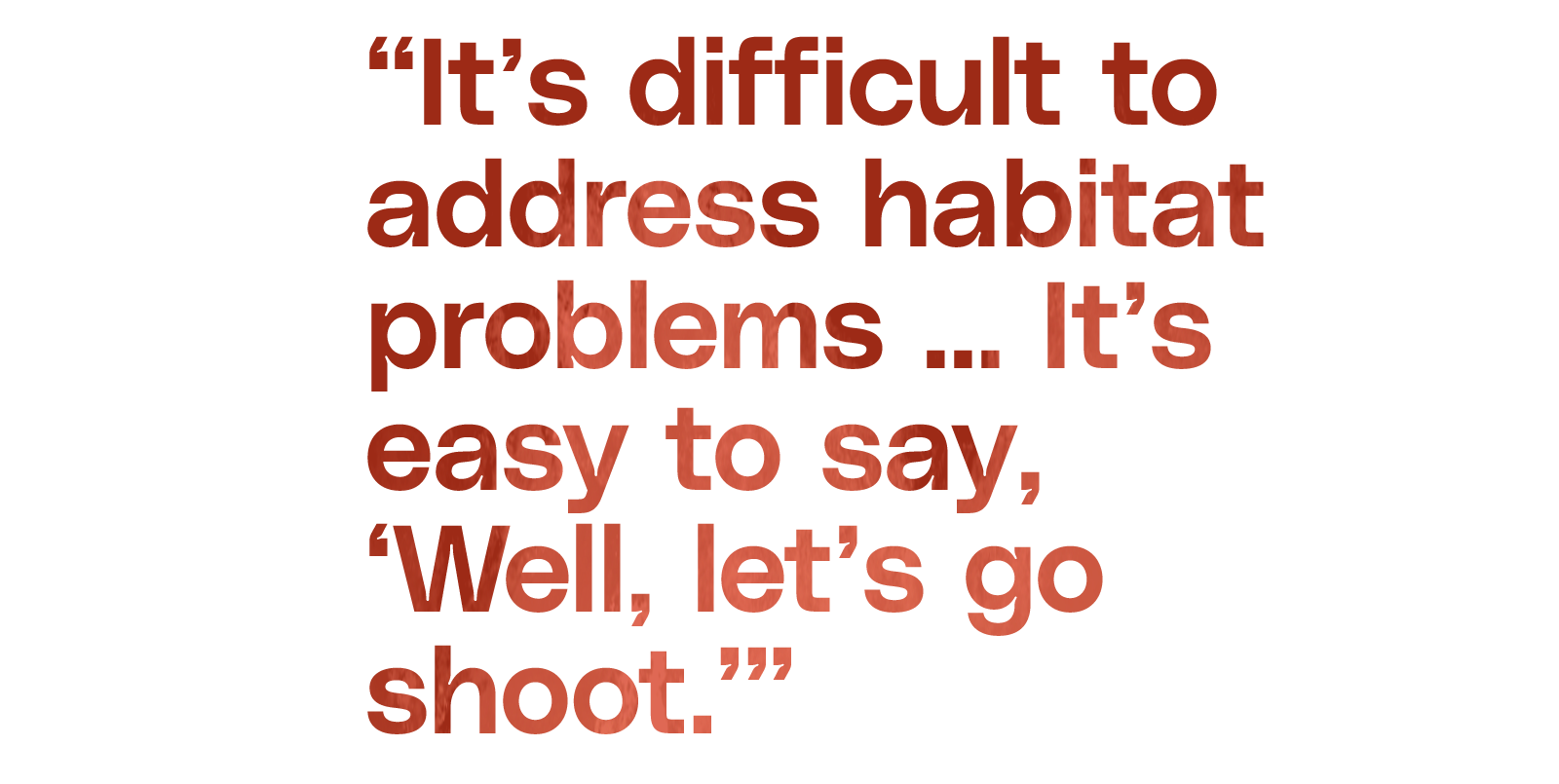
Yet despite how quickly these ecosystems are shifting, the Department of Fish and Game has no climate scientists. In the meantime, the agency is authorized to continue killing bears on the Mulchatna calving grounds every year until 2028. (The board plans to hear an annual report on the state’s intensive management later this month.) As Walsh summarizes wryly, “It’s difficult to address habitat problems. It’s difficult to address disease problems. It’s easy to say, ’Well, let’s go shoot.’”
Management decisions can feel stark in the face of nature’s complexity. The tundra is quite literally made from relationships. The lichen the caribou feed on is a symbiotic partnership between two organisms. Fungus provides its intricately branching structure, absorbing water and minerals from the air, while algae produces its energy, bringing together sunlight and soil, inseparable from the habitat they form. These connections sustain the life that blooms and eats and dies under a curving sweep of sky. It’s a system, in the truest and most obvious sense — one that includes the humans deciding what a population can recover from, and what a society can tolerate.
As another season of snow settles in, the caribou cross the landscape in great, meandering lines. There are thousands of years of migrations behind them and an uncertain future ahead. Like so much in nature, it’s hard to draw a clear threshold. “Everything is going to change,” Rogers says.
